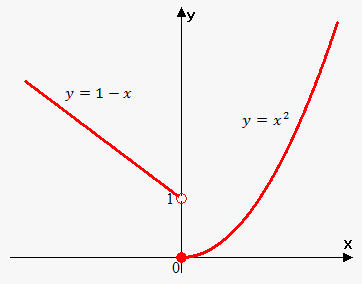Piecewise Function
When functions is determined by different formulas on different intervals then function is piecewise.
For example, $$${f{{\left({x}\right)}}}={\left\{\begin{array}{c}{1}-{x}{\quad\text{if}\quad}{x}<{0}\\{{x}}^{{2}}{\quad\text{if}\quad}{x}\ge{0}\\ \end{array}\right.}$$$ is piecewise because on interval $$${\left(-\infty,{0}\right)}$$$ $$${f{{\left({x}\right)}}}={1}-{x}$$$ and on interval $$${\left[{0},\infty\right)}$$$ $$${f{{\left({x}\right)}}}={{x}}^{{2}}$$$. 
Now find $$${f{{\left(-{2}\right)}}}$$$, $$${f{{\left({1}\right)}}}$$$, $$${f{{\left({0}\right)}}}$$$ and draw graph of this function.
Remember that function is a rule. In this case it tells us that if $$${x}<{0}$$$ then apply $$${f{{\left({x}\right)}}}={1}-{x}$$$, otherwise apply $$${f{{\left({x}\right)}}}={{x}}^{{2}}$$$.
Since $$$-{2}<{0}$$$ then we apply $$${f{{\left({x}\right)}}}={1}-{x}$$$: $$${f{{\left(-{2}\right)}}}={1}-{\left(-{2}\right)}={3}$$$.
Since $$${1}>{0}$$$ then we apply $$${f{{\left({x}\right)}}}={{x}}^{{2}}$$$: $$${f{{\left({1}\right)}}}={{1}}^{{2}}={1}$$$.
Since $$${0}\ge{0}$$$ then we apply $$${f{{\left({x}\right)}}}={{x}}^{{2}}$$$: $$${f{{\left({0}\right)}}}={{0}}^{{2}}={0}$$$.
Now, to draw this function we draw graph of the function $$${f{{\left({x}\right)}}}={1}-{x}$$$ on interval $$${\left(-\infty,{0}\right)}$$$ and graph of the function $$${f{{\left({x}\right)}}}={{x}}^{{2}}$$$ on interval $$${\left[{0},\infty\right)}$$$.
Note, that open dot indicates that it doesn't belong to the graph. Indeed, $$${f{{\left({0}\right)}}}={0}$$$, so point (0,0) is on the graph, but (0,1) is not.
